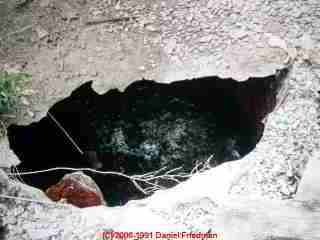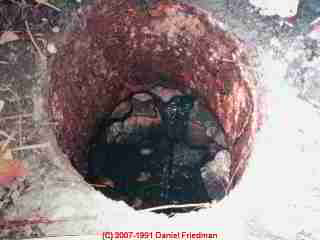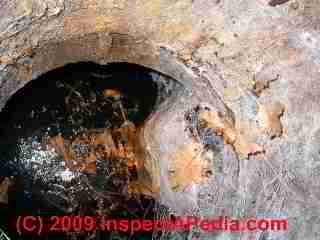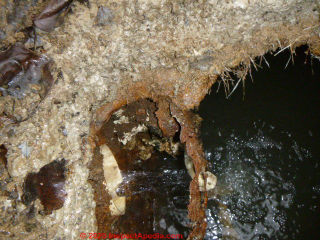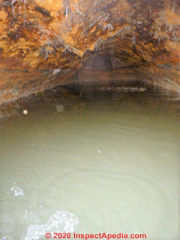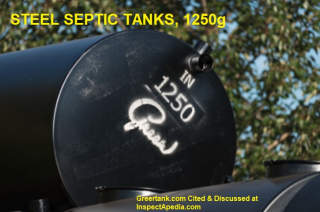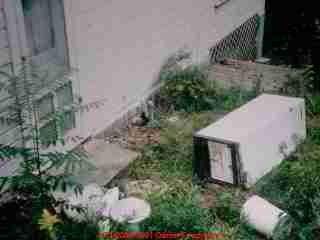 Steel Septic Tanks
Steel Septic Tanks
How to Inspect or Install a Steel Septic Tank
- POST a QUESTION or COMMENT about steel septic tanks: special problems, inspection, installation, troubleshooting, repairs, age, durability
Steel septic tank warnings:
This document describes how to inspect the condition of a septic tank, providing special considerations for inspecting steel septic tanks. Inspecting steel septic tanks is a key component in onsite wastewater disposal systems.
We describe steels septic tank defects, life expectancy, special problems, and repair methods. The page top photo shows an area where the author walked just before stepping through a rusted-out steel septic tank cover (shown below).
InspectAPedia tolerates no conflicts of interest. We have no relationship with advertisers, products, or services discussed at this website.
Steel Septic Tanks
Steel Tank Life Expectancy, What Breaks, What to Look For, How to Fix a Damaged or Leaky Steel Septic Tank or Tank Cover or Baffle
Steel septic tanks typically last 20-25 years, then rust, and collapse.
Before this time steel baffles may rust off (damaging the drain field with sludge), the tank top may become rusty and unsafe, or the tank bottom may have rusted through.
You can see the steel septic tank baffle in the lower left of this photo - notice that the top edges of the baffle have rusted away?
In the photo shown here the steel septic tank cover had rusted through and was covered with brush and about two inches of soil.
Watch out: because of their vulnerability to corrosion, reduced life and also perhaps because of some of the collapse or fall-through safety hazards we describe here, steel septic tank are not permitted in new residential septic system installations (e.g. Kansas). Several manufacturers do provide stainless steel tanks used in engineered septic systems and special wastewater treatment systems.
Guide to Steel Septic Tank Maintenance and Repair
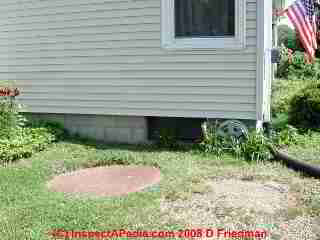
Keep surface and roof runoff away from steel septic tanks or any other septic tanks and also from other septic system components like D-boxes and drainfields.
Flooding the system with uninvited water risks shortening the drainfield life and leads to septic system failure.
In the photo the steel septic tank is not only located too close to the house (typical for the era of its installation in the 1960's), but also it is near a roof drainage downspout.
The owner has wisely added an extension to redirect downspout spillage away from this tank.
Special Hazard Warning for Steel Septic Tank Covers
Watch out: Rusting steel tank covers can cause death! Rusted covers can collapse. We have reports of children and adults who have died from this hazard, as recently as December 1997. In 2000 the author consulted in a fatality involving an adult falling into a cesspool.
At a building inspection the author, even though walking carefully, stepped through a hidden, rusted-through steel septic tank cover (shown in the photos above on this page).
At left we're not sure what the heck we've got. This may be a steel septic tank that has collapsed, or a steel access riser to a home-made (out of stones) cesspool.
This system was located less than 15 feet from a lake and cannot be working acceptably. And there was no safe cover.
Falling into a septic tank, drywell, or cesspool is quickly fatal, either from being buried by falling soils and debris, or by asphyxiation. Septic gases are highly toxic and can kill in just minutes of exposure. Even leaning over an empty (just pumped) tank has led to collapse and fatality of a septic pumper.
Special Problem with Rusted Off Baffles in Steel Septic Tanks - repair may be possible
Steel septic tank baffle problems: on a steel septic tank the inlet and outlet baffles often rust out and fall off before the owner realizes that the tank needs repair or replacement.
The baffle in this septic tank (photo at left) is on the right side of the manhole.
This damage permits solids to enter the soil absorption system. In the photo shown above on this page the steel septic tank baffle has rusted away at its top - visible in the lower left of the tank top opening.
Should we repair a steel septic tank that has lost its baffles?
If a steel septic tank is otherwise in good condition but its baffles have become damaged or have been lost entirely, try inserting a plastic tee in the inlet and outlet waste lines.
Septic tank baffles, or septic tank tees prevent solids from flowing out of the tank into the drainfield, or from blocking waste flow into the tank from the building it serves.
See SEPTIC TANK TEES for more details about this septic system component.
But if, like the steel septic tank shown above, you see that the steel septic tank baffles have been missing for some unknown time, perhaps a long time, especially at the tank outlet end, you can assume that this condition has reduced the future life of the drainfield by permitting solid waste to flow into that area of the septic system.
Above: this steel septic tank still holds effluent, but its sides are collapsing, its baffles are lost, and doubtless it sports no safe septic tank cover.
Watch out: this septic tank is unsafe, risking fatal collapse should someone walk on or even near it. The tank should be roped off and protected against access by anyone until it can be replaced.
These photos of a rusted-to-death steel septic tank are provided courtesy of Pennsylvania home inspector Larry Transue.
Steel Septic Tank Side & Bottom Rust-Out, Leaks, Abnormal Sewage Levels
Steel tank bottoms rust out permitting effluent to leak into soils around the tank, possibly giving a large void in tank at time of testing, thus subverting a loading or dye test. Since steel tank tops can be replaced while leaving the old tank in place, the condition of the top itself is not a reliable indicator of tank condition.
You may spot a leaky steel septic tank whose bottom or lower sides are gone by noticing that for a septic tank that is in use and has not just been pumped out, the level of sewage in the septic tank is lower than the outlet baffle or pipe.
Details are at SEPTIC TANK LEVELS of SEWAGE.
Technical content contributors
Special thanks to
- Lawrence Transue is a Pennsylvania building scientist and consultant, a certified ASHI home inspector, a Licensed Pesticide Applicator, a BPI Building Analyst & Envelope Professional, with 18 Years of Home Inspection Experience. He can be reached by Telephone: 610.417.0763, by Email: lawrence@lawrencetransue.com as well as at his WEBSITE and at FACEBOOK.
Steel or Metal Septic Tank Installation
Metal Septic Tank Specifications
Common carbon steel with a coal tar epoxy coating has been used for GP wetwells and septic tanks.
Prior to fabrication, the steel should be sand- or shotblasted to a “white metal’ finish as recommended by the steel structurals painting specification SP-5-63 or NACE #2.
After cleaning, fabrication, inspection and spot recleaning, the surface must be coated before oxidation can reoccur.
Coal tar epoxy or bituminous products are often specified and applied in one or two coats to a dry film thickness of 0.2 mm (8 mils.).
Magnesium anodes are normally used in conjunction with steel tanks for cathodic protection. - FL DEP cited below
Test a Steel Septic Tank Before Installation
- To insure water tightness, steel septic tanks shall be tested by filling with water to the soffit, left standing for twenty-four hours and examined for leakage. This is most important when installed in an area of high groundwater.
- Some types of tanks will require only testing of a representative sample, while with other types, each tank should be tested.
- Concrete and fiberglass septic tanks
are normally of the second category. - FL DEP cited below
Metal Septic Tank Installation Procedures
- Steel septic tanks shall be installed in accordance with the sound engineering practice.
- The excavation backfill adjacent to the installed metal septic tank should be placed in 150 mm (6 inch) lifts watered to optimum and compacted to 90% of relative density.
- Stones or debris having a diameter of 102 mm (four inches) or larger should not be included in the backfill material.
- Backfill in the vicinity of the metal septic tank inlet and outlet piping should be manually placed and consist of crushed rock to a depth of 150 mm (6 inches) over the inlet or outlet pipes with the remaining backfill placed in the same manner as adjacent to the septic tank.
- Steel septic tanks installed in soft or yielding soils should be bedded on crushed rock having a thickness of not less than 150 mm (6 inches).
- When metal septic tanks are installed in areas where groundwater will be
above the septic tank floor the septic tank shall be secured against floatation. - FL DEP cited below
See more about the prevention of this risk at
- FLOATING OIL & SEPTIC TANKS - warnings about tanks that float up out of the soil
Steel Septic Tank Risers
If the soil cover depth over the septic tank is more than a few inches (varying by jurisdiction) you should install a septic tank riser to permit easy and safe access to the septic tank cleanout openings.
The septic tank riser or wetwell and its cover may be made of steel or plastic.
Septic tank risers and wetwell covers shall be secured to preclude desired removal, but be provided sufficient clearance to vent hydrostatic pressure should a check valve fail and backflow enter the tank, unless other forms of pressure relief are provided.
Unauthorized removal of the septic tank riser or wetwell covers should be discouraged through use of a tamper-resistant construction or locking device. - FL DEP cited below
See details
Metal Septic Tank Installation Guides & Steel Septic Tank Suppliers
Illustration: a 1,250 gallon two-compartment steel septic tank provided by Greer (cited below) and buriable to 10 ft. A few companies continue to provide steel septic tanks, in addition to Greer Tank is Coburn Supply in beaumont, TX.
- Florida DEP, DESIGN AND SPECIFICATION GUIDELINES FOR LOW PRESSURE SEWER SYSTEMS [PDF] (1981) - retrieved 2022/04/25, original source: https://floridadep.gov/sites/default/files/guide_lowpres.pdf
- Greer Tank, Anchorage, AK 1-800-770-8265 Fairbanks, AK 1-800-770-1711 or Lakewood, WA 1-800-725-8108, Web: https://greertank.com/ Greer Tank provides steel septic tanks in sizes from 500 t 12,000 gallons.
- U.S. EPA, SEPTIC SYSTEM TANKS [PDF] U.S. EPA, retrieved 2022/04/25 original source: https://www3.epa.gov/npdes/pubs/septic_system_tank.pdf
- "International Private Sewage Disposal Code," 1995, BOCA-708-799-2300, ICBO-310-699-0541, SBCCI 205-591-1853, available from those code associations.
- Kansas PLUMBING CODE CHAPTER 5: SEPTIC TANKS [PDF] Kansas DHE, retrieved 2022/04/25 original source: https://www.kdhe.ks.gov/DocumentCenter/View/8966/Septic-Tanks-PDF
- "Manual of Policy, Procedures, and Guidelines for Onsite Sewage Systems," Ontario Reg. 374/81, Part VII of the Environmental Protection Act (Canada), ISBN 0-7743-7303-2, Ministry of the Environment,135 St. Clair Ave. West, Toronto Ontario M4V 1P5 Canada $24. CDN.
- New York State Department of Health, APPENDIX 75-A WASTEWATER TREATMENT STANDARDS - INDIVIDUAL HOUSEHOLD SYSTEMS , [PDF] New York State Department of Health, 3 February 2010, retrieved 3/1/2010, original source: https://www.health.ny.gov/regulations/nycrr/title_10/part_75/appendix_75-a.htm
- US EPA ONSITE WASTEWATER TREATMENT SYSTEMS MANUAL [PDF] Top Reference: US EPA's Design Manual for Onsite Wastewater Treatment and Disposal, 1980, available from the US EPA, the US GPO Superintendent of Documents (Pueblo CO)
Reader Comments, Questions & Answers About The Article Above
Below you will find questions and answers previously posted on this page at its page bottom reader comment box.
Reader Q&A - also see RECOMMENDED ARTICLES & FAQs
On 2020-05-05 - by (mod) -
Lola
Thank you for the helpful comment.
The next time you have your septic tank pumped you might want to have a careful inspection made of the condition of the baffles as well as the tank itself.
It would be no surprise if a 1960 steel septic tank had not rusted out its baffles and even rusted through the sides or bottom
On 2020-05-04 by lola
@Crystal,
Yes, it is possible. We have a concrete lid on a steel septic tank that is from 1960. Still works. How is yours holding up?
On 2019-02-07 - by (mod) -
Crystal
In the range of things people do to and at buildings sure, anything is possible, but it would be quite unusual to find a concrete lid on a metal septic tank.
Digging down just a few inches aside the lid will show you the exterior of the tank - so that's an option.
Watch out: if you see signs that the septic tank lid is tipping, settling, breaking, collapsing, then that is a very dangerous, possibly fatal hazard (if someone falls into the tank) - in that case you'd rope off or fence off the area, cover the tank with plywood, and keep people away while you call a septic contractor to investigate and repair the installation.
On 2019-02-06 by Crystal
Hello, we have a concrete lid on our septic tank. However we cannot tell what the tank is constructed of. Is it possible to have a concrete lid on a metal septic tank?
...
Continue reading at SEPTIC TANK BAFFLES or select a topic from the closely-related articles below, or see the complete ARTICLE INDEX.
Or see these
Recommended Articles
- SEPTIC SYSTEM TROUBLE: WHAT GOES WRONG
- SEPTIC TANKS - home
- SEPTIC TANK BACK FLOODING
- SEPTIC TANK BAFFLES
- SEPTIC TANK TEES
- SEPTIC TANK CLEANING
- SEPTIC TANK COVERS
- SEPTIC TANK, HOW TO FIND
- SEPTIC TANK INSTALLATION - home
- SEPTIC TANK LEAKS
- SEPTIC TANK LEVELS of SEWAGE
- SEPTIC TANK SAFETY
- SEPTIC TANK PUMPING SCHEDULE
- SEPTIC TANK COVERS
- SEPTIC TANK DEPTH
- SEPTIC TANKS FLOATING UP
- SEPTIC TANK, HOW TO FIND
- SEPTIC TANK RISERS
- SEPTIC TANK SIZE
- SEPTIC TANKS, STEEL
- SEPTIC TANK TEES
Suggested citation for this web page
SEPTIC TANKS, STEEL at InspectApedia.com - online encyclopedia of building & environmental inspection, testing, diagnosis, repair, & problem prevention advice.
Or see this
INDEX to RELATED ARTICLES: ARTICLE INDEX to SEPTIC SYSTEMS
Or use the SEARCH BOX found below to Ask a Question or Search InspectApedia
Ask a Question or Search InspectApedia
Try the search box just below, or if you prefer, post a question or comment in the Comments box below and we will respond promptly.
Search the InspectApedia website
Note: appearance of your Comment below may be delayed: if your comment contains an image, photograph, web link, or text that looks to the software as if it might be a web link, your posting will appear after it has been approved by a moderator. Apologies for the delay.
Only one image can be added per comment but you can post as many comments, and therefore images, as you like.
You will not receive a notification when a response to your question has been posted.
Please bookmark this page to make it easy for you to check back for our response.
Our Comment Box is provided by Countable Web Productions countable.ca
Citations & References
In addition to any citations in the article above, a full list is available on request.
- New York State Department of Health, APPENDIX 75-A WASTEWATER TREATMENT STANDARDS - INDIVIDUAL HOUSEHOLD SYSTEMS , [PDF] New York State Department of Health, 3 February 2010, retrieved 3/1/2010, original source: https://www.health.ny.gov/regulations/nycrr/title_10/part_75/appendix_75-a.htm
- "International Private Sewage Disposal Code," 1995, BOCA-708-799-2300, ICBO-310-699-0541, SBCCI 205-591-1853, available from those code associations.
- "Manual of Policy, Procedures, and Guidelines for Onsite Sewage Systems," Ontario Reg. 374/81, Part VII of the Environmental Protection Act (Canada), ISBN 0-7743-7303-2, Ministry of the Environment,135 St. Clair Ave. West, Toronto Ontario M4V 1P5 Canada $24. CDN.
- US HEW, MANUAL of SEPTIC TANK PRACTICE [PDF] 1975, U.S. Department of Health, Education and Welfare, Public Health Servicve, original source: https://nepis.epa.gov/
- Manual of Septic Tank Practice, US Public Health Service's 1957, reprinted in 1963, 1967, 1969 and in a 1975 edition given just above.
- SEPTIC TANK/SOIL-ABSORPTION SYSTEMS: HOW TO OPERATE & MAINTAIN [PDF] - , Equipment Tips, U.S. Department of Agriculture, 8271 1302, 7100 Engineering, 2300 Recreation, September 1982, web search 08/28/2010, original source: http://www.fs.fed.us/t-d/pubs/pdfimage/82711302.pdf.
- Our recommended books about building & mechanical systems design, inspection, problem diagnosis, and repair, and about indoor environment and IAQ testing, diagnosis, and cleanup are at the InspectAPedia Bookstore. Also see our Book Reviews - InspectAPedia.
- In addition to citations & references found in this article, see the research citations given at the end of the related articles found at our suggested
CONTINUE READING or RECOMMENDED ARTICLES.
- Carson, Dunlop & Associates Ltd., 120 Carlton Street Suite 407, Toronto ON M5A 4K2. Tel: (416) 964-9415 1-800-268-7070 Email: info@carsondunlop.com. Alan Carson is a past president of ASHI, the American Society of Home Inspectors.
Thanks to Alan Carson and Bob Dunlop, for permission for InspectAPedia to use text excerpts from The HOME REFERENCE BOOK - the Encyclopedia of Homes and to use illustrations from The ILLUSTRATED HOME .
Carson Dunlop Associates provides extensive home inspection education and report writing material. In gratitude we provide links to tsome Carson Dunlop Associates products and services.


